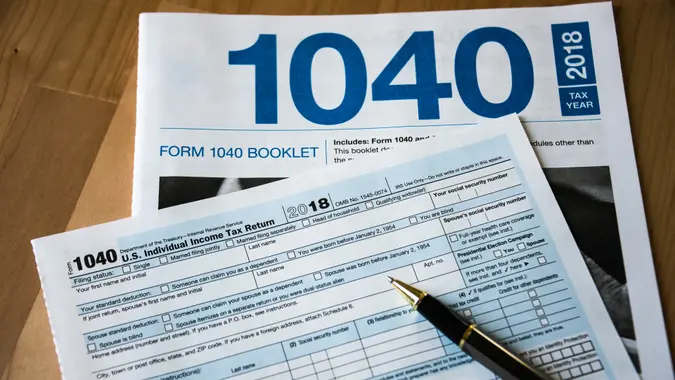Stimulus Update: Here’s How You Can Collect $1,400 in 2023

Commitment to Our Readers
GOBankingRates' editorial team is committed to bringing you unbiased reviews and information. We use data-driven methodologies to evaluate financial products and services - our reviews and ratings are not influenced by advertisers. You can read more about our editorial guidelines and our products and services review methodology.

20 Years
Helping You Live Richer

Reviewed
by Experts

Trusted by
Millions of Readers
Between Apr. 2020 and Dec. 2021, Congress approved the issuing of three stimulus checks totaling $931 billion to aid eligible individuals and families during the pandemic. Most individuals making below $75,000 or married couples making below $150,000 qualified for the relief payments.
Although the IRS has issued all third-round Economic Impact Payments (EIPs) and all plus-up payments as of Dec. 31, 2021, those who missed out on a $1,400 check or got less than the full amount may still be able to get a check by claiming a 2021 Recovery Rebate Credit on their 2021 federal tax return.
As CNBC reported, a Treasury Department report in September 2022 revealed that 644,705 people had not received a third stimulus payment. While many people have since received the stimulus payment due to them, there is still time to collect your $1,400 if you’re eligible.
Furthermore, if you didn’t file taxes for 2020 and missed out on the first and second stimulus checks of $1,200 and $600, respectively, you can claim a Recovery Rebate Credit by filing a 2020 income tax return.
Authorized through the American Rescue Plan Act, the third stimulus payment of $1,400 was made available to eligible individuals and dependents. Couples who file jointly could get up to $2,800.
The IRS has closed the Get My Payment application portal to check the status of your stimulus payments, but those missing stimulus payments can still view the total of all three payments by securely logging into their individual Online Account.
If you have ever received a Letter 6475 from the IRS detailing the total amount of your third EIP and any plus-up payments for the 2021 tax year, you will need it or the information found in your Online Account to calculate your Recovery Rebate Credit when preparing your 2021 tax return.
Additionally, according to the IRS, individuals and families who had added dependents or had changes in income between 2020 and 2021 may be able to receive $1,400 or a partial payment by claiming the Recovery Rebate Credit for the 2021 tax year. These include:
- Parents of a child born in 2021 who claim the child as a dependent on their 2021 income tax return (eligible parents of qualifying children should also look into claiming the Child Tax Credit, which was worth up to $3,600 per child born in 2021).
- Families who added a dependent — like a parent, a nephew or niece or a grandchild — on their 2021 income tax return who was not listed as a dependent on their 2020 income tax return.
- Individuals whose income changed from 2020 to 2021 (single filers who had incomes above $80,000 in 2020 but less than this amount in 2021, married couples who filed a joint return and had incomes above $160,000 in 2020 but less than this amount in 2021 or heads of households who had incomes above $120,000 in 2020 but less than this amount in 2021).
- Single filers who had income lowered to full eligibility between 2020 and 2021 (single filers who had incomes between $75,000 and $80,000 in 2020 but had lower incomes in 2021, married couples who filed a joint return and had incomes between $150,000 and $160,000 in 2020 but had lower incomes in 2021 and heads of households who had incomes between $112,500 and $120,000 in 2020 but had lower incomes in 2021).
More eligibility and tax filing information can be found on the “Questions and Answers About the Third-Round Economic Impact Payment” IRS Fact Sheet.
 Written by
Written by  Edited by
Edited by 

























